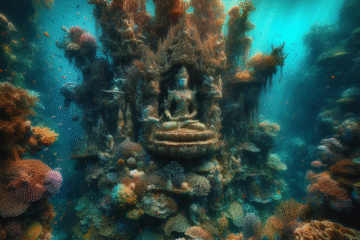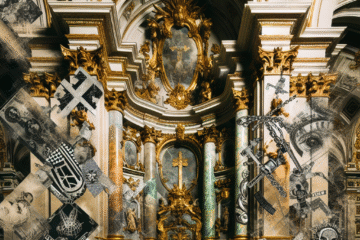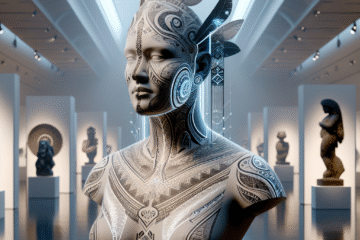Introduction:
Contemporary art is a diverse and constantly evolving field that encompasses a wide range of mediums, styles, and approaches. Defined as art that is produced in the present time, contemporary art often reflects the social, political, and cultural issues of the current moment, and can challenge traditional artistic conventions and expectations.
Contemporary art has become an important part of the art world, with artists from around the world creating work that pushes the boundaries of creativity and explores new forms of artistic expression. In this article, we will explore the ways in which contemporary artists are pushing the limits of creativity in their work, and the impact that this is having on the art world as a whole.
The purpose of this article is to examine how contemporary artists are expanding the boundaries of artistic expression, and to showcase some of the most innovative and exciting work being produced today. From new technologies and materials to unconventional approaches and collaborations, contemporary artists are finding new ways to create and connect with their audiences, and are helping to shape the future of art.
Contemporary art is not just about creating visually stunning work, it is also about exploring ideas and concepts that challenge our perceptions of the world and encourage us to think and engage with art in new and different ways. By pushing the boundaries of creativity, contemporary artists are helping to expand the possibilities of what art can be, and are contributing to a vibrant and dynamic art world that is constantly evolving.
In the following sections, we will explore the evolution of contemporary art, the different ways in which contemporary artists are exploring the boundaries of creativity, the role of the audience in contemporary art, and the potential directions that contemporary art could take in the future. Through this exploration, we hope to provide a deeper understanding of the significance and impact of contemporary art, and to inspire readers to engage with and explore this exciting and constantly evolving field.
II. The Evolution of Contemporary Art:
Contemporary art has its roots in the early 20th century, with the emergence of movements such as cubism, fauvism, and expressionism. These movements rejected traditional artistic techniques and styles, and instead embraced new approaches that emphasized individual expression and emotional intensity.
In the decades that followed, contemporary art continued to evolve, with artists experimenting with a wide range of mediums, styles, and approaches. One of the most significant movements of the mid-20th century was abstract expressionism, which emerged in the aftermath of World War II and emphasized large-scale, spontaneous, and gestural paintings that were meant to convey intense emotional and psychological states.
The 1960s saw the emergence of minimalism, which rejected the emotional intensity of abstract expressionism in favor of a pared-down, geometric aesthetic. Artists such as Donald Judd and Dan Flavin created minimalist sculptures and installations that emphasized the physical properties of materials such as steel and fluorescent light.
In the 1970s and 1980s, contemporary art became more politically engaged, with artists addressing issues such as feminism, racial and social inequality, and the AIDS epidemic. Artists such as Cindy Sherman and Barbara Kruger used photography and other mediums to explore the representation of women and the power dynamics of contemporary society, while Keith Haring and David Wojnarowicz created work that addressed the stigma and discrimination faced by the LGBTQ+ community.
The 1990s and early 2000s saw the emergence of a wide range of new movements and styles, including installation art, digital art, and conceptual art. These movements often sought to blur the boundaries between art and everyday life, with artists creating immersive, interactive, and site-specific works that challenged traditional notions of artistic display and spectatorship.
Today, contemporary art continues to evolve and expand, with artists from around the world pushing the boundaries of creativity and exploring new forms of artistic expression. Key movements and artists that have helped shape the current state of contemporary art include:
- Pop Art: Developed in the 1950s and 1960s, Pop Art embraced popular culture and mass media as its subject matter, often using bright colors, bold graphics, and humorous or satirical commentary. Key artists include Andy Warhol and Roy Lichtenstein.
- Postmodernism: A movement that emerged in the 1970s and 1980s, postmodernism sought to critique and deconstruct traditional artistic and cultural forms, often through the use of parody, irony, and pastiche. Key artists include Cindy Sherman, Jeff Koons, and Barbara Kruger.
- Street Art: A form of art that often uses public spaces as its canvas, street art includes graffiti, murals, and other forms of urban intervention. Key artists include Banksy, Shepard Fairey, and JR.
- New Media Art: A movement that emerged in the 1990s and 2000s, new media art incorporates digital technologies such as video, virtual reality, and interactive installations. Key artists include Nam June Paik, Bill Viola, and Cory Arcangel.
Overall, the evolution of contemporary art reflects the changing cultural and social landscape of the world, as well as the ongoing experimentation and exploration of artists. By constantly pushing the boundaries of creativity and challenging traditional notions of artistic expression, contemporary artists are helping to shape the future of art and contribute to a dynamic and ever-evolving art world.
III. Exploring the Boundaries of Creativity:
Creativity is at the heart of contemporary art. It is the process of generating new and innovative ideas, as well as the ability to take risks and break from tradition to create something entirely new. For contemporary artists, creativity is not only important for their individual practice but also for pushing the boundaries of the art form as a whole.
Contemporary artists today are pushing the limits of creativity in ways that challenge our perceptions of what art can be. They are constantly experimenting with new materials, techniques, and technologies, as well as pushing the boundaries of what is considered “art.” In this section, we will highlight examples of contemporary artists who are exploring the boundaries of creativity in their work and discuss the different ways that they are doing so.
- Use of New Technologies:
Contemporary artists are increasingly incorporating new technologies into their work, using them to create interactive, immersive, and thought-provoking experiences. For example, artist Refik Anadol uses machine learning algorithms to create mesmerizing digital installations that blend art and technology. Another example is the immersive installations of teamLab, a Tokyo-based group of artists, designers, and engineers who create large-scale, interactive digital environments.
- Unconventional Materials:
Contemporary artists are also exploring the use of unconventional materials in their work, creating pieces that challenge our assumptions about what constitutes “art.” For example, artist Cornelia Parker created a sculpture made from the charred remains of a church that had been struck by lightning, while artist El Anatsui creates large-scale tapestries from recycled bottle caps.
- Innovative Techniques:
Contemporary artists are also experimenting with new techniques to create unique and innovative works of art. For example, artist Olafur Eliasson uses light and reflection to create immersive installations that challenge our perceptions of space and time. Another example is the works of artist Tara Donovan, who creates large-scale sculptures using everyday materials such as drinking straws or plastic cups.
- Collaborations:
Contemporary artists are also collaborating with other artists, scientists, and designers to push the boundaries of creativity in new and exciting ways. For example, artist and architect Maya Lin collaborated with scientists and environmentalists to create a series of large-scale installations that raise awareness about climate change and the environment.
Overall, contemporary artists are exploring the boundaries of creativity in a multitude of ways. By using new technologies, unconventional materials, innovative techniques, and collaborations, they are creating work that challenges our perceptions of what art can be and opens up new avenues for creative expression. Through their experimentation and innovation, contemporary artists are helping to shape the future of art and inspire future generations of artists to push the boundaries even further.
IV. The Role of the Audience:
Contemporary art is a collaborative effort between the artist and the audience. While the artist creates the work, it is the audience that gives it meaning and purpose. Without the audience, contemporary art would not exist. Therefore, it is important to consider the role of the audience in contemporary art and how they contribute to pushing the boundaries of creativity.
In recent years, there has been a shift towards more interactive and participatory forms of contemporary art, in which the audience is invited to engage with the work in new and exciting ways. Interactive art creates an immersive experience for the audience, allowing them to become an active participant in the work, rather than just a passive observer. This type of art challenges the traditional notion of the audience as a detached spectator, and encourages them to engage with the work on a more personal level.
The role of the audience in contemporary art is multifaceted. First, the audience provides a critical response to the work. By experiencing the work and offering feedback, the audience can help the artist to understand how their work is being received and interpreted. This feedback can help the artist to refine their ideas and push the boundaries of creativity.
Second, the audience can contribute to the creative process. Through interactive and participatory art, the audience can collaborate with the artist to create a unique and dynamic work of art. This type of collaboration can push the boundaries of creativity and lead to new and innovative forms of artistic expression.
Finally, the audience can contribute to the social and cultural impact of the work. Contemporary art often addresses important social, political, and cultural issues, and the audience’s response to the work can help to shape public discourse and raise awareness about these issues.
One example of interactive contemporary art is the work of artist Yayoi Kusama, whose installations invite the audience to become part of the artwork. Her Infinity Mirror Rooms create a unique and immersive experience for the audience, as they are surrounded by an endless array of reflections and patterns. Another example is the work of Olafur Eliasson, who creates installations that play with light, reflection, and perception, inviting the audience to become an active participant in the work.
The role of the audience in contemporary art is constantly evolving, as artists continue to push the boundaries of creativity and explore new ways of engaging with their audience. By encouraging participation, collaboration, and feedback, contemporary artists are creating work that is both innovative and inclusive, and is helping to shape the future of art.
V. The Future of Contemporary Art:
Contemporary art is a constantly evolving and dynamic field, and the future of art promises to be just as exciting and innovative as the past. As new technologies emerge, and artists continue to push the boundaries of creativity, contemporary art is poised to enter a new era of experimentation and exploration.
One potential direction for contemporary art in the future is the increased use of virtual and augmented reality. These technologies offer new possibilities for creating immersive and interactive experiences that blur the line between art and reality. Artists can use these technologies to create unique and dynamic installations that transport the audience to new and exciting places. For example, artist teamLab creates immersive digital installations that use projected light and motion sensors to create a fully interactive and immersive environment.
Another emerging trend in contemporary art is the incorporation of artificial intelligence (AI) and machine learning. This technology allows artists to create works that can evolve and adapt over time, responding to the audience or the environment in real-time. AI also offers new possibilities for creating works that challenge our assumptions about creativity and authorship. For example, the artist Mario Klingemann creates digital art using neural networks and machine learning algorithms to generate unique and unpredictable works.
In addition to these new technologies, contemporary artists are also exploring new forms of collaboration and community-building. The art world is becoming more inclusive and diverse, and artists are seeking out new ways to connect with audiences and each other. Social media and online platforms offer new possibilities for connecting with audiences and sharing work, while artist collectives and collaborative projects offer new opportunities for working together and creating something truly unique.
Finally, contemporary artists are likely to continue pushing the boundaries of what is considered “art.” As the art world becomes more diverse and inclusive, the definition of art is likely to become more expansive, encompassing a wider range of mediums, styles, and approaches. Artists are likely to continue experimenting with unconventional materials and techniques, as well as exploring the intersections of art and other fields such as science, technology, and politics.
In conclusion, the future of contemporary art promises to be a dynamic and exciting time, as artists continue to push the boundaries of creativity and explore new forms of artistic expression. With the emergence of new technologies, the increased focus on collaboration and community-building, and the growing diversity of the art world, the possibilities for creativity and innovation are virtually limitless.
VI. Conclusion:
In this article, we have explored the world of contemporary art and how artists are pushing the boundaries of creativity in their work. We discussed the evolution of contemporary art, highlighting key movements and artists that have helped shape the current state of contemporary art. We also examined the role of the audience in contemporary art, discussing how interactive and participatory art is redefining the relationship between the artist and the audience. Finally, we looked towards the future of contemporary art, discussing emerging trends and potential directions for the art form.
The importance of pushing the boundaries of creativity in contemporary art cannot be overstated. By constantly experimenting with new materials, techniques, and technologies, artists are expanding the possibilities of what art can be, and are helping to shape the future of the art world. Interactive and participatory art is also expanding the role of the audience, creating a more inclusive and collaborative environment that encourages experimentation and innovation.
As we move into the future, it is important for artists, audiences, and the art world as a whole to continue exploring new and innovative approaches to contemporary art. We must continue to push the boundaries of creativity and challenge traditional artistic conventions, in order to create works that are truly unique and thought-provoking. By doing so, we can create a more vibrant and dynamic art world that reflects the diverse and complex world we live in.
In conclusion, contemporary art offers an exciting and ever-evolving field for artists and audiences alike. By continuing to push the boundaries of creativity and explore new approaches to artistic expression, we can create a future for contemporary art that is vibrant, inclusive, and dynamic.


